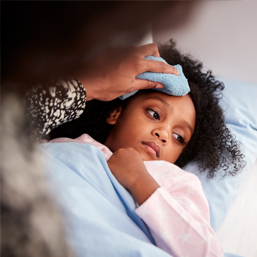
It is sometimes quite difficult for a parent to know if their child should be kept home from daycare or school and when their recovering child can be sent back. The decision is made much more difficult when alternate child-care arrangements are not easy to make or when a parent must stay home from work to care for the child. This article will outline some common scenarios and will offer some guidelines to follow in making the decision. Remember that these are just guidelines and that numerous other factors may need to be considered as well.
Whenever a child has a significant fever (38.5 degrees Celsius) they should not go to daycare or school, even if they are acting relatively normal. This is because fevers indicate that an infection is present. Even though the most common infections are relatively benign viral infections such as colds, the child should rest, be kept well-hydrated and be kept away from other children and adults to prevent the spread of the illness. When the fever has been gone for 24 hours and the child is no longer lethargic, they may return to daycare or school. If the fever disappears but they still have a cough they should be kept home until the cough is infrequent and not excessively “wet” or “chesty” sounding. A runny nose alone is not an indication to need to stay home.
Children who have been vomiting should be kept home until they have been able to keep food and liquids down for 24 hours and they are back to their usual energy level. When they have had diarrhea, they may return when they have not had a loose bowel movement for 24 hours and are eating and feeling well.
COVID-19 infections can occur at virtually any age. When a child has any COVID-type symptoms, which are usually fever, respiratory or gastrointestinal, they should remain out of daycare or school until they are better, as outlined above. Longer periods of time at home, if mandated or recommended by the government and public health, need to be followed. These recommendations change frequently so it is a good idea for parents to periodically review the “Alberta Health Services COVID-19 Information for Albertans” website.
“Pink eye” or conjunctivitis is an eye infection in which the white of the eye becomes red and there is a discharge. Regardless of whether it is viral or bacterial it is highly contagious. If it is viral, the child may have other cold-like symptoms. In both types, the discharge is most noticeable upon awakening (with the eyelids “stuck shut”) and either one or both eyes can be affected. In bacterial conjunctivitis there is usually a much greater amount of discharge produced continually throughout the day. Despite the fact that the majority of conjunctivitis is viral and therefore antibiotics are not useful, it is difficult to determine whether the cause is viral or bacterial. Therefore, many daycares and schools insist on the child being kept out until they have received at least 24 hours of an antibiotic eye drop or ointment.
Hand, foot and mouth disease is a very contagious viral illness, which causes multiple small, painful blisters and sores mainly on the areas of the body listed in its title. It is most common in pre-school and kindergarten-aged children. The sores in the mouth often contribute to poor appetite and difficulty keeping the child hydrated. In addition, the child will often have a fever. They should be kept home until there is no fever, their appetite and hydration are normal and there are no open sores which would still contain infectious viral particles that can cause others to get ill. Unfortunately, like a lot of viral infections, transmission to others has often already occurred in the few days prior to the child becoming ill. However, it is important to not increase exposure to non-infected children.
Sprained ankles, wrists and knees are more common in older children. In general, if there is a significant amount of pain and swelling the first decision to be made is whether they need urgent assessment and if so, to access it. If that is not needed, the child will still likely need to stay home from school for a while to elevate the injured area, apply cold packs and receive pain medication if needed. When the joint pain has improved to the point that function is largely restored (e.g. the child can walk with very little limping) they may return to school.
Sometimes a child will awaken just not feeling well. They may not have a fever or any other obvious sign of illness but may just be somewhat lethargic or have a poor appetite. Whether or not that child is kept home from school depends on how unusual this behavior is for them. Gently enquiring about things that may be bothering them is helpful in determining whether this is school-avoidance behavior from something that needs to be addressed. Overall, giving them the benefit of the doubt and arranging for them to have a day away from school to see how things play out is probably worth it.
In conclusion, there are indeed some circumstances when a child should stay home from daycare or school because of illness or injury. When in doubt it is usually better to err on the side of caution, both for the child’s comfort and for the health of their classmates and teachers/caregivers.
Dr. Cathryn Kuzyk has been a family physician for 41 years and is a mother of four and grandmother of three.
See our related articles:
Calgary’s Child Magazine © 2025 Calgary’s Child